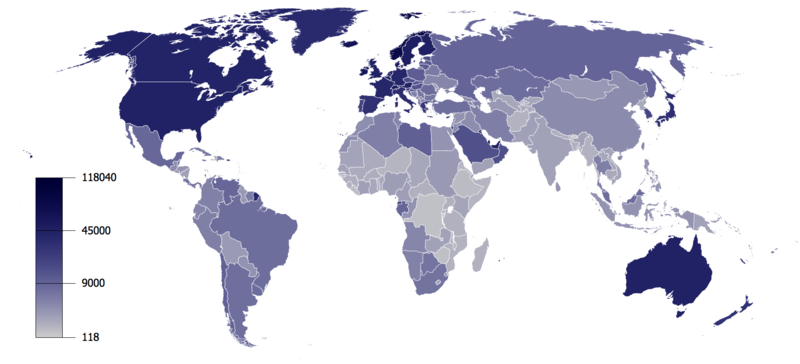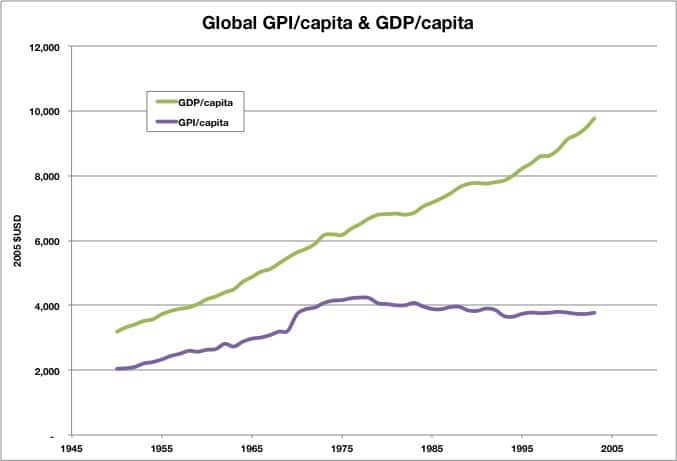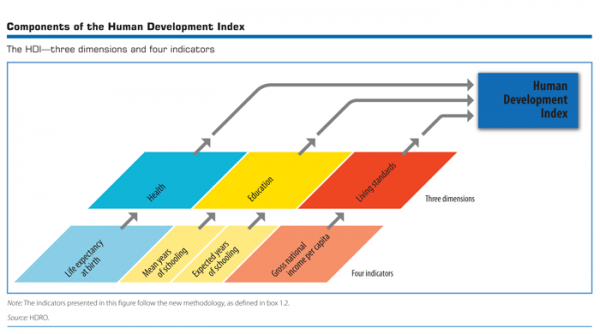Measuring economic welfare is not an exact science. Often in economics, we focus on GDP statistics (measuring national output). However, quality of life depends on many other factors apart from just GDP.
Quality of Life Indicators

- GDP – the total output of an economy. This is a guide to national output and influences the level of consumption. Higher GDP enables a country to alleviate levels of absolute poverty.
- Distribution of Income in society. e.g. looking at the Gini Co-efficient. and how income is distributed. Some countries have high GDP per capita, but some people still live in poverty.
- Employment / Unemployment. Unemployment is one of the main economic causes of poor life changes. Also, quality of employment, e.g. widespread part-time/temporary contracts may suggest underemployment in the economy.
- Life Expectancy. Dependent on health care standards, environmental factors and cultural factors
- Education Standards. One simple measure is the rate of literacy in an economy. For example, Sri Lanka has a higher rate of literacy than Saudi Arabia, despite a lower GDP per capita.
- Housing. The standard and quality of housing and related amenities. Also, include the rate of homelessness.
- Air Pollution. The quality of air can influence the quality of life and also health issues.
- Levels of Congestion and Transport. Congestion can lead to time lost sitting in traffic jams as well as being frustrated. For example, average traffic speeds (11mph) in London (2010) are similar to 100 years ago when we still used the horse and cart
- Environmental Standards. Quality and quantity of ‘green spaces’ where people can escape pressures of cities, e.g. London does quite well on this measure.
- Wildlife Diversity. Protection of wildlife and areas of natural beauty important. e.g. a new road may reduce congestion but damage areas of outstanding natural beauty.
- Access to clean drinking Water. Basic necessity is often taken for granted in West, a but, is big issue in the developing world.
- Climate. Climate can make some areas inhospitable leading to defensive spending, e.g. spending on air-conditioning or heating. Global Warming could tip the ecological balance in some countries with fragile eco-balance.
- Social Investment v Present Consumption. GDP doesn’t measure what is actually produced and consumed. A state with high military spending will have lower living standards than a country that invests heavily in public transport, education and healthcare.
Quality of life measures
Composite indexes include
- Human development index (HDI)
- Genuine Progress Indicator (GPI)
Human Development Index HDI
The Human development index looks at three main factors – living standards, health and education
More on Human development index HDI
Measure of economic welfare (MEW)
Genuine Progress Indicator GPI

The GPI includes a wide measure of factors affecting the quality of life. In particular, it includes material well-being, but also time/leisure factors and the natural environment. The GPI measure includes:
GPI = A + B – C – D + I
- A is income weighted private consumption
- B is value of non-market services generating welfare
- C is private defensive cost of natural deterioration
- D is cost of deterioration of nature and natural resources
- I is an increase in capital stock and balance of international trade
- More on Genuine Progress Indicator (GPI)
World Happiness Report 2022
There is a global happiness report which takes into account
- GDP per capita
- Healthy life expectancy
- Freedom to make life choices
- Generosity in society
- Perceptions of corruption
The top 20 countries by happiness satisfaction are
| 1 | Finland | 7.821 |
| 2 | Denmark | 7.636 |
| 3 | Iceland | 7.557 |
| 4 | Switzerland | 7.512 |
| 5 | Netherlands | 7.415 |
| 6 | Luxembourg* | 7.404 |
| 7 | Sweden | 7.384 |
| 8 | Norway | 7.365 |
| 9 | Israel | 7.364 |
| 10 | New Zealand | 7.200 |
| 11 | Austria | 7.163 |
| 12 | Australia | 7.162 |
| 13 | Ireland | 7.041 |
| 14 | Germany | 7.034 |
| 15 | Canada | 7.025 |
| 16 | United States | 6.977 |
| 17 | United Kingdom | 6.943 |
| 18 | Czechia | 6.920 |
| 19 | Belgium | 6.805 |
| 20 | France | 6.687 |
Countries with the lowest reported satisfaction are
| 120 | Tunisia | 4.516 |
| 121 | Pakistan | 4.516 |
| 122 | Palestinian Territories* | 4.483 |
| 123 | Mali | 4.479 |
| 124 | Namibia | 4.459 |
| 125 | Eswatini, Kingdom of* | 4.396 |
| 126 | Myanmar | 4.394 |
| 127 | Sri Lanka | 4.362 |
| 128 | Madagascar* | 4.339 |
| 129 | Egypt | 4.288 |
| 130 | Chad* | 4.251 |
| 131 | Ethiopia | 4.241 |
| 132 | Yemen* | 4.197 |
| 133 | Mauritania* | 4.153 |
| 134 | Jordan | 4.152 |
| 135 | Togo | 4.112 |
| 136 | India | 3.777 |
| 137 | Zambia | 3.760 |
| 138 | Malawi | 3.750 |
| 139 | Tanzania | 3.702 |
| 140 | Sierra Leone | 3.574 |
| 141 | Lesotho* | 3.512 |
| 142 | Botswana* | 3.471 |
| 143 | Rwanda* | 3.268 |
| 144 | Zimbabwe | 2.995 |
| 145 | Lebanon | 2.955 |
| 146 | Afghanistan | 2.404 |
Further reading


Excellent summary! Would you send me the sources youhave used for this summary? I would like to use it for teaching. Tks!
Excellent summary! Would you send me the sources youhave used for this summary? I would like to use it for teaching. Tks!
Excellent summary! Would you send me the sources youhave used for this summary? I would like to use it for teaching. Tks!